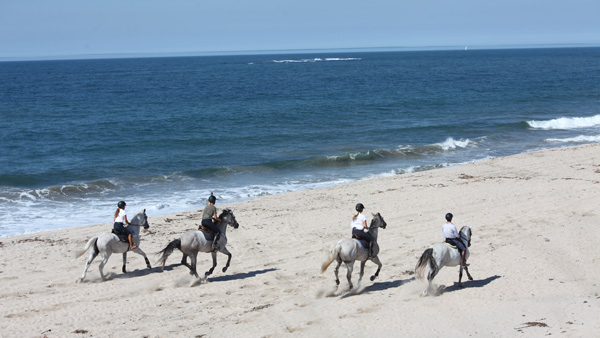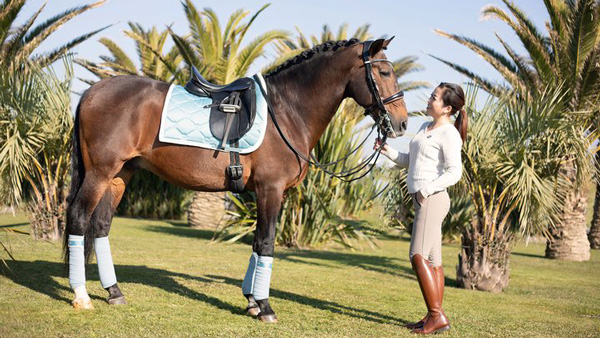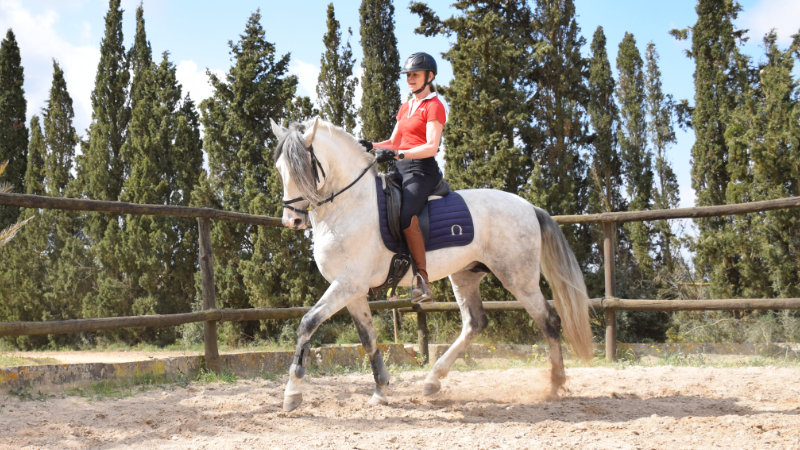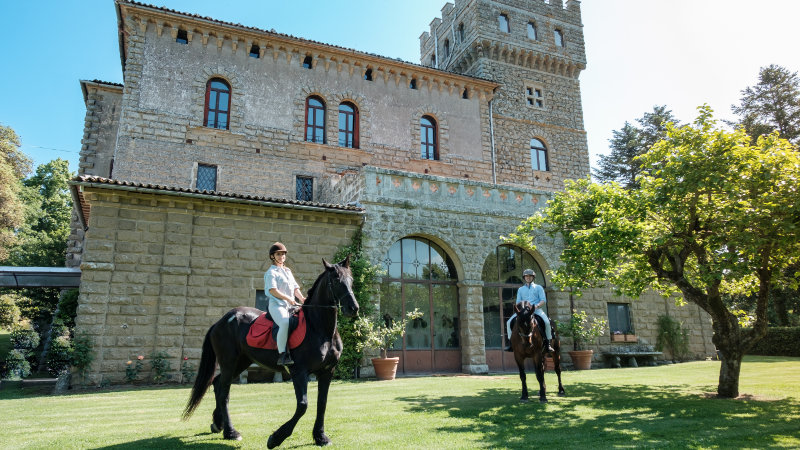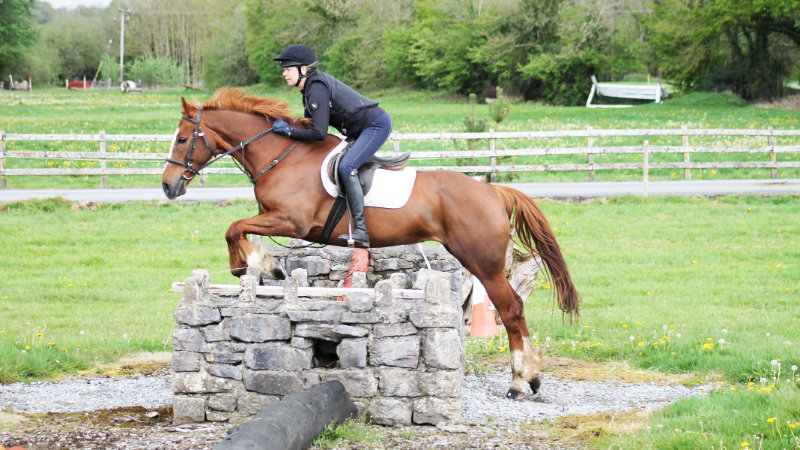| 15/05/2025 | 4 | Portugal, Porto - Training Weekend, 5 lessons Fully booked | EUR 1,115 | Book on request |
| 15/05/2025 | 4 | Portugal, Porto - Countryside rides & lessons, Weekend Fully booked | EUR 1,115 | Book on request |
| 18/05/2025 | 7 | Portugal, Porto - Training week - standard, 10 lessons Fully booked | EUR 1,850 | Book on request |
| 18/05/2025 | 7 | Portugal, Porto - Countryside rides & lessons, Week Fully booked | EUR 1,850 | Book on request |
| 18/05/2025 | 13 | Portugal, Porto - Intensiveprogram, 20 lessons Fully booked | EUR 3,500 | Book on request |
| 22/05/2025 | 4 | Portugal, Porto - Training Weekend, 5 lessons Fully booked | EUR 1,115 | Book on request |
| 22/05/2025 | 4 | Portugal, Porto - Countryside rides & lessons, Weekend Fully booked | EUR 1,115 | Book on request |
| 25/05/2025 | 7 | Portugal, Porto - Training week - standard, 10 lessons Fully booked | EUR 1,850 | Book on request |
| 25/05/2025 | 7 | Portugal, Porto - Countryside rides & lessons, Week Fully booked | EUR 1,850 | Book on request |
| 25/05/2025 | 13 | Portugal, Porto - Intensiveprogram, 20 lessons Fully booked | EUR 3,680 | Book on request |
| 29/05/2025 | 4 | Portugal, Porto - Training Weekend, 5 lessons | EUR 1,115 | Book on request |
| 29/05/2025 | 4 | Portugal, Porto - Countryside rides & lessons, Weekend | EUR 1,115 | Book on request |
| 01/06/2025 | 7 | Portugal, Porto - Training week - standard, 10 lessons | EUR 1,940 | Book on request |
| 01/06/2025 | 7 | Portugal, Porto - Countryside rides & lessons, Week | EUR 1,940 | Book on request |
| 01/06/2025 | 13 | Portugal, Porto - Intensiveprogram, 20 lessons | EUR 3,680 | Book on request |
| 05/06/2025 | 4 | Portugal, Porto - Training Weekend, 5 lessons | EUR 1,160 | Book on request |
| 05/06/2025 | 4 | Portugal, Porto - Countryside rides & lessons, Weekend | EUR 1,160 | Book on request |
| 08/06/2025 | 7 | Portugal, Porto - Training week - standard, 10 lessons | EUR 1,940 | Book on request |
| 08/06/2025 | 7 | Portugal, Porto - Countryside rides & lessons, Week | EUR 1,940 | Book on request |
| 08/06/2025 | 13 | Portugal, Porto - Intensiveprogram, 20 lessons | EUR 3,680 | Book on request |
| 12/06/2025 | 4 | Portugal, Porto - Training Weekend, 5 lessons | EUR 1,160 | Book on request |
| 12/06/2025 | 4 | Portugal, Porto - Countryside rides & lessons, Weekend | EUR 1,160 | Book on request |
| 15/06/2025 | 7 | Portugal, Porto - Training week - standard, 10 lessons Fully booked | EUR 1,940 | Book on request |
| 15/06/2025 | 7 | Portugal, Porto - Countryside rides & lessons, Week Fully booked | EUR 1,940 | Book on request |
| 15/06/2025 | 13 | Portugal, Porto - Intensiveprogram, 20 lessons Fully booked | EUR 3,680 | Book on request |
| 19/06/2025 | 4 | Portugal, Porto - Training Weekend, 5 lessons Fully booked | EUR 1,160 | Book on request |
| 19/06/2025 | 4 | Portugal, Porto - Countryside rides & lessons, Weekend Fully booked | EUR 1,160 | Book on request |
| 22/06/2025 | 7 | Portugal, Porto - Training week - standard, 10 lessons Fully booked | EUR 1,940 | Book on request |
| 22/06/2025 | 7 | Portugal, Porto - Countryside rides & lessons, Week Fully booked | EUR 1,940 | Book on request |
| 22/06/2025 | 13 | Portugal, Porto - Intensiveprogram, 20 lessons Fully booked | EUR 3,680 | Book on request |
| 26/06/2025 | 4 | Portugal, Porto - Training Weekend, 5 lessons Fully booked | EUR 1,160 | Book on request |
| 26/06/2025 | 4 | Portugal, Porto - Countryside rides & lessons, Weekend Fully booked | EUR 1,160 | Book on request |
| 29/06/2025 | 7 | Portugal, Porto - Training week - standard, 10 lessons Fully booked | EUR 1,940 | Book on request |
| 29/06/2025 | 7 | Portugal, Porto - Countryside rides & lessons, Week Fully booked | EUR 1,940 | Book on request |
| 29/06/2025 | 13 | Portugal, Porto - Intensiveprogram, 20 lessons Fully booked | EUR 3,680 | Book on request |
| 03/07/2025 | 4 | Portugal, Porto - Training Weekend, 5 lessons Fully booked | EUR 1,160 | Book on request |
| 03/07/2025 | 4 | Portugal, Porto - Countryside rides & lessons, Weekend Fully booked | EUR 1,160 | Book on request |
| 06/07/2025 | 7 | Portugal, Porto - Training week - standard, 10 lessons Fully booked | EUR 1,940 | Book on request |
| 06/07/2025 | 7 | Portugal, Porto - Countryside rides & lessons, Week Fully booked | EUR 1,940 | Book on request |
| 06/07/2025 | 13 | Portugal, Porto - Intensiveprogram, 20 lessons Fully booked | EUR 3,680 | Book on request |
| 10/07/2025 | 4 | Portugal, Porto - Training Weekend, 5 lessons Fully booked | EUR 1,160 | Book on request |
| 10/07/2025 | 4 | Portugal, Porto - Countryside rides & lessons, Weekend Fully booked | EUR 1,160 | Book on request |
| 13/07/2025 | 7 | Portugal, Porto - Training week - standard, 10 lessons | EUR 1,940 | Book on request |
| 13/07/2025 | 7 | Portugal, Porto - Countryside rides & lessons, Week | EUR 1,940 | Book on request |
| 13/07/2025 | 13 | Portugal, Porto - Intensiveprogram, 20 lessons Fully booked | EUR 3,680 | Book on request |
| 17/07/2025 | 4 | Portugal, Porto - Training Weekend, 5 lessons | EUR 1,160 | Book on request |
| 17/07/2025 | 4 | Portugal, Porto - Countryside rides & lessons, Weekend | EUR 1,160 | Book on request |
| 03/08/2025 | 7 | Portugal, Porto - Training week - standard, 10 lessons Fully booked | EUR 1,940 | Book on request |
| 03/08/2025 | 7 | Portugal, Porto - Countryside rides & lessons, Week Fully booked | EUR 1,940 | Book on request |
| 03/08/2025 | 13 | Portugal, Porto - Intensiveprogram, 20 lessons Fully booked | EUR 3,680 | Book on request |
| 07/08/2025 | 4 | Portugal, Porto - Training Weekend, 5 lessons Fully booked | EUR 1,160 | Book on request |
| 07/08/2025 | 4 | Portugal, Porto - Countryside rides & lessons, Weekend Fully booked | EUR 1,160 | Book on request |
| 10/08/2025 | 7 | Portugal, Porto - Training week - standard, 10 lessons | EUR 1,940 | Book on request |
| 10/08/2025 | 7 | Portugal, Porto - Countryside rides & lessons, Week | EUR 1,940 | Book on request |
| 10/08/2025 | 13 | Portugal, Porto - Intensiveprogram, 20 lessons | EUR 3,680 | Book on request |
| 14/08/2025 | 4 | Portugal, Porto - Training Weekend, 5 lessons | EUR 1,160 | Book on request |
| 14/08/2025 | 4 | Portugal, Porto - Countryside rides & lessons, Weekend | EUR 1,160 | Book on request |
| 17/08/2025 | 7 | Portugal, Porto - Training week - standard, 10 lessons | EUR 1,940 | Book on request |
| 17/08/2025 | 7 | Portugal, Porto - Countryside rides & lessons, Week | EUR 1,940 | Book on request |
| 17/08/2025 | 13 | Portugal, Porto - Intensiveprogram, 20 lessons | EUR 3,680 | Book on request |
| 21/08/2025 | 4 | Portugal, Porto - Training Weekend, 5 lessons | EUR 1,160 | Book on request |
| 21/08/2025 | 4 | Portugal, Porto - Countryside rides & lessons, Weekend | EUR 1,160 | Book on request |
| 24/08/2025 | 7 | Portugal, Porto - Training week - standard, 10 lessons | EUR 1,940 | Book on request |
| 24/08/2025 | 7 | Portugal, Porto - Countryside rides & lessons, Week | EUR 1,940 | Book on request |
| 24/08/2025 | 13 | Portugal, Porto - Intensiveprogram, 20 lessons | EUR 3,680 | Book on request |
| 28/08/2025 | 4 | Portugal, Porto - Training Weekend, 5 lessons Fully booked | EUR 1,160 | Book on request |
| 28/08/2025 | 4 | Portugal, Porto - Countryside rides & lessons, Weekend Fully booked | EUR 1,160 | Book on request |
| 31/08/2025 | 7 | Portugal, Porto - Training week - standard, 10 lessons Fully booked | EUR 1,850 | Book on request |
| 31/08/2025 | 7 | Portugal, Porto - Countryside rides & lessons, Week Fully booked | EUR 1,850 | Book on request |
| 31/08/2025 | 13 | Portugal, Porto - Intensiveprogram, 20 lessons Fully booked | EUR 3,500 | Book on request |
| 04/09/2025 | 4 | Portugal, Porto - Training Weekend, 5 lessons Fully booked | EUR 1,115 | Book on request |
| 04/09/2025 | 4 | Portugal, Porto - Countryside rides & lessons, Weekend Fully booked | EUR 1,115 | Book on request |
| 07/09/2025 | 7 | Portugal, Porto - Training week - standard, 10 lessons Fully booked | EUR 1,850 | Book on request |
| 07/09/2025 | 7 | Portugal, Porto - Countryside rides & lessons, Week Fully booked | EUR 1,850 | Book on request |
| 07/09/2025 | 13 | Portugal, Porto - Intensiveprogram, 20 lessons Fully booked | EUR 3,500 | Book on request |
| 11/09/2025 | 4 | Portugal, Porto - Training Weekend, 5 lessons Fully booked | EUR 1,115 | Book on request |
| 11/09/2025 | 4 | Portugal, Porto - Countryside rides & lessons, Weekend Fully booked | EUR 1,115 | Book on request |
| 14/09/2025 | 7 | Portugal, Porto - Training week - standard, 10 lessons Fully booked | EUR 1,850 | Book on request |
| 14/09/2025 | 7 | Portugal, Porto - Countryside rides & lessons, Week Fully booked | EUR 1,850 | Book on request |
| 14/09/2025 | 13 | Portugal, Porto - Intensiveprogram, 20 lessons Fully booked | EUR 3,500 | Book on request |
| 18/09/2025 | 4 | Portugal, Porto - Training Weekend, 5 lessons Fully booked | EUR 1,115 | Book on request |
| 18/09/2025 | 4 | Portugal, Porto - Countryside rides & lessons, Weekend Fully booked | EUR 1,115 | Book on request |
| 21/09/2025 | 7 | Portugal, Porto - Training week - standard, 10 lessons Fully booked | EUR 1,850 | Book on request |
| 21/09/2025 | 7 | Portugal, Porto - Countryside rides & lessons, Week Fully booked | EUR 1,850 | Book on request |
| 21/09/2025 | 13 | Portugal, Porto - Intensiveprogram, 20 lessons Fully booked | EUR 3,500 | Book on request |
| 25/09/2025 | 4 | Portugal, Porto - Training Weekend, 5 lessons Fully booked | EUR 1,115 | Book on request |
| 25/09/2025 | 4 | Portugal, Porto - Countryside rides & lessons, Weekend Fully booked | EUR 1,115 | Book on request |
| 28/09/2025 | 7 | Portugal, Porto - Training week - standard, 10 lessons Fully booked | EUR 1,850 | Book on request |
| 28/09/2025 | 7 | Portugal, Porto - Countryside rides & lessons, Week Fully booked | EUR 1,850 | Book on request |
| 28/09/2025 | 13 | Portugal, Porto - Intensiveprogram, 20 lessons Fully booked | EUR 3,500 | Book on request |
| 02/10/2025 | 4 | Portugal, Porto - Training Weekend, 5 lessons Fully booked | EUR 1,115 | Book on request |
| 02/10/2025 | 4 | Portugal, Porto - Countryside rides & lessons, Weekend Fully booked | EUR 1,115 | Book on request |
| 05/10/2025 | 7 | Portugal, Porto - Training week - standard, 10 lessons | EUR 1,850 | Book on request |
| 05/10/2025 | 7 | Portugal, Porto - Countryside rides & lessons, Week | EUR 1,850 | Book on request |
| 05/10/2025 | 13 | Portugal, Porto - Intensiveprogram, 20 lessons | EUR 3,500 | Book on request |
| 09/10/2025 | 4 | Portugal, Porto - Training Weekend, 5 lessons | EUR 1,115 | Book on request |
| 09/10/2025 | 4 | Portugal, Porto - Countryside rides & lessons, Weekend | EUR 1,115 | Book on request |
| 12/10/2025 | 7 | Portugal, Porto - Training week - standard, 10 lessons Fully booked | EUR 1,850 | Book on request |
| 12/10/2025 | 7 | Portugal, Porto - Countryside rides & lessons, Week Fully booked | EUR 1,850 | Book on request |
| 12/10/2025 | 13 | Portugal, Porto - Intensiveprogram, 20 lessons Fully booked | EUR 3,500 | Book on request |
| 16/10/2025 | 4 | Portugal, Porto - Training Weekend, 5 lessons | EUR 1,115 | Book on request |
| 16/10/2025 | 4 | Portugal, Porto - Countryside rides & lessons, Weekend | EUR 1,115 | Book on request |
| 19/10/2025 | 7 | Portugal, Porto - Training week - standard, 10 lessons | EUR 1,850 | Book on request |
| 19/10/2025 | 7 | Portugal, Porto - Countryside rides & lessons, Week | EUR 1,850 | Book on request |
| 19/10/2025 | 13 | Portugal, Porto - Intensiveprogram, 20 lessons | EUR 3,500 | Book on request |
| 23/10/2025 | 4 | Portugal, Porto - Training Weekend, 5 lessons | EUR 1,115 | Book on request |
| 23/10/2025 | 4 | Portugal, Porto - Countryside rides & lessons, Weekend | EUR 1,115 | Book on request |
| 26/10/2025 | 7 | Portugal, Porto - Training week - standard, 10 lessons | EUR 1,850 | Book on request |
| 26/10/2025 | 7 | Portugal, Porto - Countryside rides & lessons, Week | EUR 1,850 | Book on request |
| 26/10/2025 | 13 | Portugal, Porto - Intensiveprogram, 20 lessons | EUR 3,500 | Book on request |
| 30/10/2025 | 4 | Portugal, Porto - Training Weekend, 5 lessons | EUR 1,115 | Book on request |
| 30/10/2025 | 4 | Portugal, Porto - Countryside rides & lessons, Weekend | EUR 1,115 | Book on request |
| 02/11/2025 | 7 | Portugal, Porto - Training week - standard, 10 lessons | EUR 1,700 | Book on request |
| 02/11/2025 | 7 | Portugal, Porto - Countryside rides & lessons, Week | EUR 1,700 | Book on request |
| 02/11/2025 | 13 | Portugal, Porto - Intensiveprogram, 20 lessons | EUR 3,200 | Book on request |
| 06/11/2025 | 4 | Portugal, Porto - Training Weekend, 5 lessons | EUR 1,040 | Book on request |
| 06/11/2025 | 4 | Portugal, Porto - Countryside rides & lessons, Weekend | EUR 1,040 | Book on request |
| 09/11/2025 | 7 | Portugal, Porto - Training week - standard, 10 lessons | EUR 1,700 | Book on request |
| 09/11/2025 | 7 | Portugal, Porto - Countryside rides & lessons, Week | EUR 1,700 | Book on request |
| 09/11/2025 | 13 | Portugal, Porto - Intensiveprogram, 20 lessons | EUR 3,200 | Book on request |
| 13/11/2025 | 4 | Portugal, Porto - Training Weekend, 5 lessons | EUR 1,040 | Book on request |
| 13/11/2025 | 4 | Portugal, Porto - Countryside rides & lessons, Weekend | EUR 1,040 | Book on request |
| 16/11/2025 | 7 | Portugal, Porto - Training week - standard, 10 lessons | EUR 1,700 | Book on request |
| 16/11/2025 | 7 | Portugal, Porto - Countryside rides & lessons, Week | EUR 1,700 | Book on request |
| 16/11/2025 | 13 | Portugal, Porto - Intensiveprogram, 20 lessons | EUR 3,200 | Book on request |
| 20/11/2025 | 4 | Portugal, Porto - Training Weekend, 5 lessons | EUR 1,040 | Book on request |
| 20/11/2025 | 4 | Portugal, Porto - Countryside rides & lessons, Weekend | EUR 1,040 | Book on request |
| 23/11/2025 | 7 | Portugal, Porto - Training week - standard, 10 lessons | EUR 1,700 | Book on request |
| 23/11/2025 | 7 | Portugal, Porto - Countryside rides & lessons, Week | EUR 1,700 | Book on request |
| 23/11/2025 | 13 | Portugal, Porto - Intensiveprogram, 20 lessons | EUR 3,200 | Book on request |
| 27/11/2025 | 4 | Portugal, Porto - Training Weekend, 5 lessons | EUR 1,040 | Book on request |
| 27/11/2025 | 4 | Portugal, Porto - Countryside rides & lessons, Weekend | EUR 1,040 | Book on request |
| 30/11/2025 | 7 | Portugal, Porto - Training week - standard, 10 lessons | EUR 1,700 | Book on request |
| 30/11/2025 | 7 | Portugal, Porto - Countryside rides & lessons, Week | EUR 1,700 | Book on request |
| 30/11/2025 | 13 | Portugal, Porto - Intensiveprogram, 20 lessons | EUR 3,200 | Book on request |
| 04/12/2025 | 4 | Portugal, Porto - Training Weekend, 5 lessons | EUR 1,040 | Book on request |
| 04/12/2025 | 4 | Portugal, Porto - Countryside rides & lessons, Weekend | EUR 1,040 | Book on request |
| 07/12/2025 | 7 | Portugal, Porto - Training week - standard, 10 lessons | EUR 1,700 | Book on request |
| 07/12/2025 | 7 | Portugal, Porto - Countryside rides & lessons, Week | EUR 1,700 | Book on request |
| 07/12/2025 | 13 | Portugal, Porto - Intensiveprogram, 20 lessons | EUR 3,200 | Book on request |
| 11/12/2025 | 4 | Portugal, Porto - Training Weekend, 5 lessons | EUR 1,040 | Book on request |
| 11/12/2025 | 4 | Portugal, Porto - Countryside rides & lessons, Weekend | EUR 1,040 | Book on request |
| 14/12/2025 | 7 | Portugal, Porto - Training week - standard, 10 lessons | EUR 1,700 | Book on request |
| 14/12/2025 | 7 | Portugal, Porto - Countryside rides & lessons, Week | EUR 1,700 | Book on request |
| 18/12/2025 | 4 | Portugal, Porto - Countryside rides & lessons, Weekend | EUR 1,040 | Book on request |
| 18/12/2025 | 4 | Portugal, Porto - Training Weekend, 5 lessons | EUR 1,040 | Book on request |










